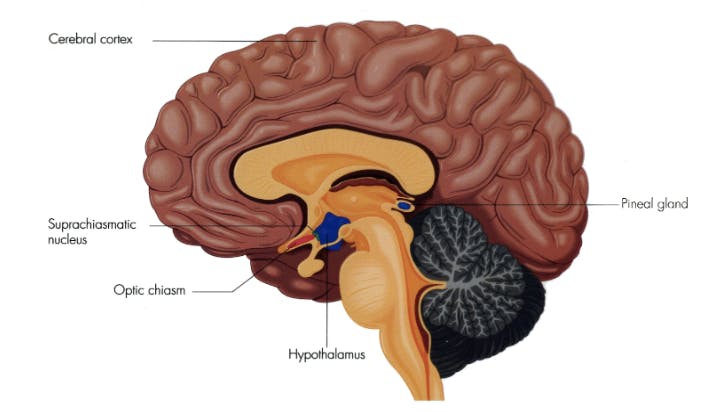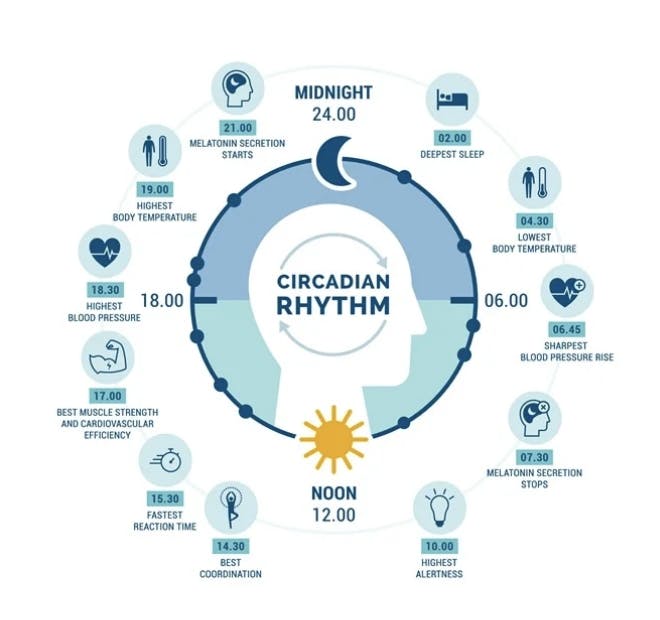TL;DR Science: Sleep and Circadian Rhythm
By Srishti S.
September 01, 2023 · 4 minute read
After a long day of school, extracurriculars, and hanging out with friends, there is one thing that we all look forward to at the end: a good night’s rest. Some of us doze off as soon as our head hits the pillow, but for others, it takes much longer to fall asleep. Some of us are fresher in the morning, while others are their most productive selves late at night! What causes all of these differences in our sleep and energy patterns, and what makes us tired as the sky turns darker? The answer lies in what's called a circadian rhythm.
What is a circadian rhythm?
Let’s just focus on the terminology here: a circadian rhythm doesn’t always have to relate to sleep! This term is derived from the Latin phrase circa diem, which means about a day. In other words, circadian rhythms are processes within organisms that operate on a 24-hour cycle. These rhythms are not just limited to humans; for example, animals that are nocturnal know not to go out during daylight (when they are most susceptible to predators) because of their 24-hour circadian rhythm.
From a human standpoint, circadian rhythms regulate many of the processes that occur within the body, from producing specific proteins during mealtimes to releasing hormones from the endocrine system on a 24-hour rotation. However, circadian rhythms are most widely discussed in terms of the sleep-wake cycle.
How do circadian rhythms work?
To understand how circadian rhythms function, we have to take a closer look into the brain! The hypothalamus is a small part of the brain that essentially acts as the link between the nervous system and the endocrine system in the human body. Within the hypothalamus is a collection of nerve cells known as the suprachiasmatic nucleus (more commonly known as SCN). The SCN acts as a “biological clock” of sorts that controls the timing of different activities throughout the body. Now, the interesting thing about the SCN is that it is closely connected to the optic nerve (check out my last article on the SciTeens website to learn more)! As a result of this connection, the SCN is sensitive to light picked up by the optic nerve, causing the sleep-wake cycle to operate on a 24-hour basis just like the cycle of night and day!

Light is the most significant external factor that affects circadian rhythms, but other elements like temperature and overexertion through physical activity can also have a big impact.
Now, let’s return to our discussion of the circadian rhythm’s impact on sleep. When it gets dark during the night, the SCN (our internal clock) starts to produce melatonin, the hormone that helps us sleep. Keep in mind that since the SCN is able to do this because of its connection to the endocrine system that controls the production of hormones, as mentioned earlier. Throughout the night, the SCN also continues to transmit signals that keep us asleep.
As daylight breaks, the SCN takes those light cues from the optic nerve and sends signals to raise body temperature, delay melatonin production, increase heart rate, and perform other actions that help the body become active and alert. By following this pattern of taking in light or dark and sending specific signals to initiate processes throughout the body, our sleep-wake cycle is able to coordinate itself to day and night. We can thank our circadian rhythm for letting us rest and optimizing our performance for the next day!
Refer to the picture below to get a better understanding of how our circadian rhythm controls our body at different times of the day.

The time when the human body craves sleep the most is from 2 AM to 4 AM; however, there is also a period of time from 2 PM to 3 PM when the body might need some additional rest in accordance with its circadian rhythm. This is why mid-day naps are completely normal (and even encouraged by many experts): they help to maximize productivity throughout the day and boost health in the long run.
“Resetting”
Circadian rhythms can be thrown off for a multitude of reasons, from jet lag to working night shifts. It is important to maintain a healthy circadian rhythm to prevent conditions like insomnia and other sleep or mental health disorders. Some abnormal circadian rhythms can be the result of genetics, as well. However, with a proper night routine, good sleeping habits, and possibly medical intervention, we have the ability to “reset” our circadian rhythms and keep them healthy.
Here is a great video about sleep and circadian rhythm if you want to learn more!
TL;DR
The cycle of sleeping and waking up is made possible by our body’s circadian rhythms. While circadian rhythms can vary from person to person, they must remain stable in order to regulate the timings of our bodily processes on a daily basis!
Sources:
https://www.sleepfoundation.org/circadian-rhythm
https://nigms.nih.gov/education/fact-sheets/Pages/circadian-rhythms.aspx
Image Sources:
https://d2jx2rerrg6sh3.cloudfront.net/image-handler/picture/2021/2/shutterstock_1742387510.jpg
Did you enjoy this article?
About The Author
Srishti Swaminathan is a rising high school junior interested in STEM and writing. She enjoys reading, listening to music, and watching movies. If you have any comments or questions regarding this article, feel free to contact her at srishti@sciteens.org.